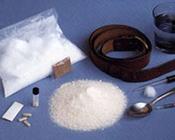
The
International Narcotics Control Board (INCB) sounds the alarm on the rapid increase in the illicit manufacture of
methamphetamine, in its Annual Report released today (1 March 2006), in
Vienna.
Besides rapidly increasing in
North America and South-East Asia, the illicit manufacture of methamphetamine is also spreading to other regions such as
Africa, Eastern Europe and Oceania. This trend is fuelled by traffickers' ability to divert ephedrine and pseudoephedrine, the key precursors for methamphetamine, from licit distribution channels.
Following the monitoring of nearly 2,000 shipments of ephedrine and pseudoephedrine
in licit international trade in 2005, the Board was able to zero in on a series of suspicious shipments of the two substances. These shipments were headed towards
North America and South-East Asia, where illicit methamphetamine manufacture is known to take place, but also to countries in
Africa and Central and South America. The largest of those cases include the prevented diversion of
26 tons of pseudoephedrine to the Democratic Republic of the Congo and 7.3 tons to Kenya, 19.5 tons of ephedrine to Paraguay, and 3 tons each of ephedrine and pseudoephedrine to Belize.Traffickers take advantage of existing loopholes in the international and national control regimes to obtain precursors for methamphetamine manufacture.
Bulk ephedrine and pseudoephedrine are controlled under the 1988 Convention; however, these measures apply only to the raw material, not to pharmaceutical preparations containing those substances. To counter the situation, the Board recommends extending existing controls to the pharmaceutical products containing these substances.
INCB has also developed an electronic system which helps exporting and importing countries exchange notifications, thus making it easier to monitor illicit trade.
In the
Americas, traffickers are turning to new routes of diversion and to preparations containing pseudoephedrine as a source for illicit methamphetamine manufacture. In response, under Project Prism, the international initiative focusing on ATS precursors, Governments have started to introduce voluntary measures to identify and prevent such diversions, such as the assessment of licit requirements in the substance and the sending of pre-export notifications for pharmaceutical preparations containing pseudoephedrine.
Exports of pseudoephedrine to Mexico increased five-fold between 1998 and 2004.A number of suspicious shipments of pseudoephedrine to that country were identified in 2005. In response, the
Mexican authorities have prohibited brokers from importing pseudoephedrine, and reduced imports of the substance by half.
To counter methamphetamine manufacture, the Board urges all Governments to assess and report their countries' licit requirements for ephedrine and pseudoephedrine.
Source:International Narcotics Control Boardhttp://www.incb.org/incb/index.htmlhttp://pdf2html.pootwerdie.com/pdf2html.php?url=http://www.incb.org/pdf/e/press/2006/press_release_2006-03-01_6.pdf
 Hundreds of Hospital Pharmacists and other scientists from the health care sector were attended the 11th Congress of the EAHP from 22nd – 24th March 2006 in Geneva.
Hundreds of Hospital Pharmacists and other scientists from the health care sector were attended the 11th Congress of the EAHP from 22nd – 24th March 2006 in Geneva.







